
|

View into the starting shaft. The individual components are clearly visible: the jacking pipe (1), the main press station consisting of the jacking cylinders (3) including all necessary hydraulic equipment as well as the thrust wall (4) and the thrust ring made of steel (2). (Image: View into the starting shaft - Arrangement for pipe jacking) (Image: Damage to the jacking abutment due to inadequate dimensioning - Jacking forces cannot be absorbed by … |

|

|
(Image: Attention!)
When choosing and/or arranging the jacking cylinders care must be taken of the following facts: -
the jacking cylinders used are identical in construction
-
the force resulting from the jacking force corresponds to the longitudinal axis of the pipe string
-
the jacking cylinders are arranged symmetrically with regards to the pipe cross-section
|
|
|
|
(Image: Use of two jacking cylinders combined with a steel pressure ring for four … |
|
|
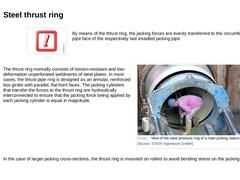
|

By means of the thrust ring, the jacking forces are evenly transferred to the circumference of the pipe face of the respectively last installed jacking pipe The thrust ring normally consists of torsion-resistant and low-deformation unperforated weldments of steel plates. In most cases, the pipe ring is designed as an annular, reinforced box girder with parallel, flat front faces. The jacking cylinders that transfer the forces to … |
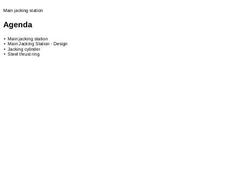
|

|
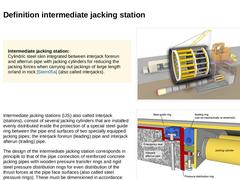
|

Intermediate jacking station:
Cylindric steel cylinder integrated between interjack forerun and afterrun pipe with jacking cylinders for reducing the jacking forces when carrying out jackings of large length or/and in rock [Stein05a] (also called interjacks). (Image: Technical components in pipe jacking - intermediate jacking station) Intermediate jacking stations (IJS) also called interjack (stations), consist of several jacking cylinders that are … |

|

(Image: Intermediate jacking station - view of the jacking cylinders) (Image: Design and arrangement of intermediate jacking stations - Detail view of the jacking cylinders) (Image: Intermediate jacking station before installation of the cylinders) (Image: Built-in and activated cylinders of an intermediate jacking station) (Image: Intermediate jacking station before the installation in the pipeline tract)Intermediate jacking stations are integrated … |

|

Intermediate jacking stations are divided into two groups The recoverable IJS are installed from nominal size DN/ID 500 either immediately behind or at a short distance behind the jacking or shield machine and are pushed out of the target shaft with the pipe string or they are placed in the jacking string in such a way that the IJS is positioned exactly in an intermediate shaft after the end of the jacking and can be recovered … |
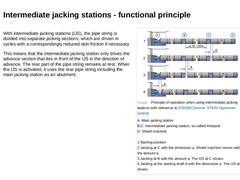
|

With intermediate jacking stations (IJS), the pipe string is divided into separate jacking sections, which are driven in cycles with a correspondingly reduced skin friction if necessary. This means that the intermediate jacking station only drives the advance section that lies in front of the IJS in the direction of advance. The rear part of the pipe string remains at rest. When the IJS is activated, it uses the rear pipe string including the main … |
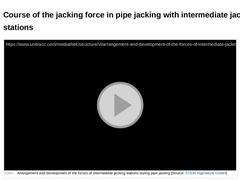
|

(Video: Arrangement and development of the forces of intermediate jacking stations during pipe jacking) Video:Arrangement and development of the forces of intermediate jacking stations during pipe jacking [Image: S&P GmbH]. This interactive object is only visible online. |
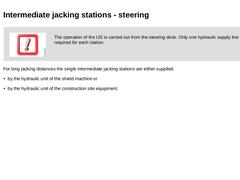
|

|
(Image: Attention!)
The operation of the IJS is carried out from the steering desk. Only one hydraulic supply line is required for each station. |
For long jacking distances the single intermediate jacking stations are either supplied |
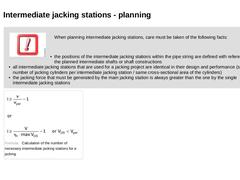
|

|
(Image: Attention!)
When planning intermediate jacking stations, care must be taken of the following facts: -
the positions of the intermediate jacking stations within the pipe string are defined with reference to the planned intermediate shafts or shaft constructions
-
all intermediate jacking stations that are used for a jacking project are identical in their design and performance (same number of jacking cylinders per intermediate jacking station / …
|
|

|

|
(Image: Pros and cons)
When using intermediate jacking stations, the following disadvantages must be expected: -
increase in costs due to the installation and the storage of all necessary system parts as well as the activation
-
reduction of the jacking performance
|
|

|

|
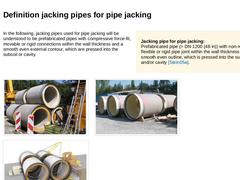
|

In the following, jacking pipes used for pipe jacking will be understood to be prefabricated pipes with compressive force-fit, movable or rigid connections within the wall thickness and a smooth even external contour, which are pressed into the subsoil or cavity. Jacking pipe for pipe jacking:
Prefabricated pipe (> DN 1200 (48 in)) with non-restrained, flexible or rigid pipe joint within the wall thickness and smooth even outline, which is pressed … |
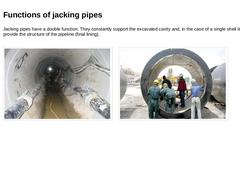
|

Jacking pipes have a double function: They constantly support the excavated cavity and, in the case of a single shell lining, they provide the structure of the pipeline (final lining). (Image: View into the jacking pipes) (Image: Reinforced concrete jacking pipes) |
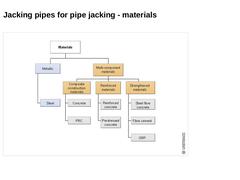
|

(Image: Materials for jacking pipes used in pipe jacking) |

|

|

|

A shield machine is a steerable shoring construction, in the protection of which the soil / rock on the working face is excavated manually, mechanically or hydraulically. It consists of at least two flexible connected steel pipe pieces, the front shield segment and the trailing shield segment, which is supported by the jacking pipe string. A distinction is made here between open and closed shields or shields with partial and full face excavation.… |

|

|
(Image: Attention!)
The feature of shield machines, also called shields, for pipe jacking, is that the thrust jacks (jacking cylinders) are situated not in the shield machine, but in the (main) jacking station or in the first intermediate jacking station. |
|
The soil or rock material can be excavated at the working face with the following methods: |
|

|

|
The duties of the shield machine in pipe jacking are as follows [Scher77a]: -
To protect the personnel,
-
To create the necessary cavity so that the following pipe string can be pressed in with a minimum degree of soil deformation and with the lowest possible skin friction,
-
To protect the cavity until the jacking pipes can finally carry all the loads and forces,
-
To secure the working face against collapsing soil and rock as well as groundwater, …
|
|

|

|
2-component shield machine (Image: Design of a 2-component shield machine) |
3-component shield machine (Image: Design of a 3-component shield machine) |
|

|

(Image: Overview of shield machine types) |

|

Open shields:
Shield machine without pressure tight sealing between the working face and the following pipe string [Stein05a]. Open shields do not have a pressure-tight seal between the working face and the subsequent pipe string. They are characterized by relatively good access to the working face and easy-to-use machine technique. (Image: Hand shields - Overall view of a hand shield (external diameter 2098 mm) [FI-Nishi]) (Image: Open shield) (Image: … |

|

Shield machines with partial excavation feature an open (SM-T1 or SM-T2) or closed shield (SM-T3 or SMT4) and partial loosening of the soil or material at the working face. Shield machines with partial excavation of the working face are grouped according to the method of excavation into: -
Shield machines with partial excavation by hand (hand shields)
-
Shield machines with mechanical partial excavation
-
Shield machines with hydraulic partial excavation
|
|

|

|
Closed shields:
Shield machines equipped with a pressure bulkhead between the working face and the shield tail in order to build up an artificial pressure at the working face [Stein05a]. |
(Image: Possible designs of boring heads for earth pressure balance shields - Shield with eight-spoke cutting wheel and circumferential rim (external diameter 3100 mm) [Breme])
Closed shields are – depending on the used pressure balancing fluid – executed with … |
|